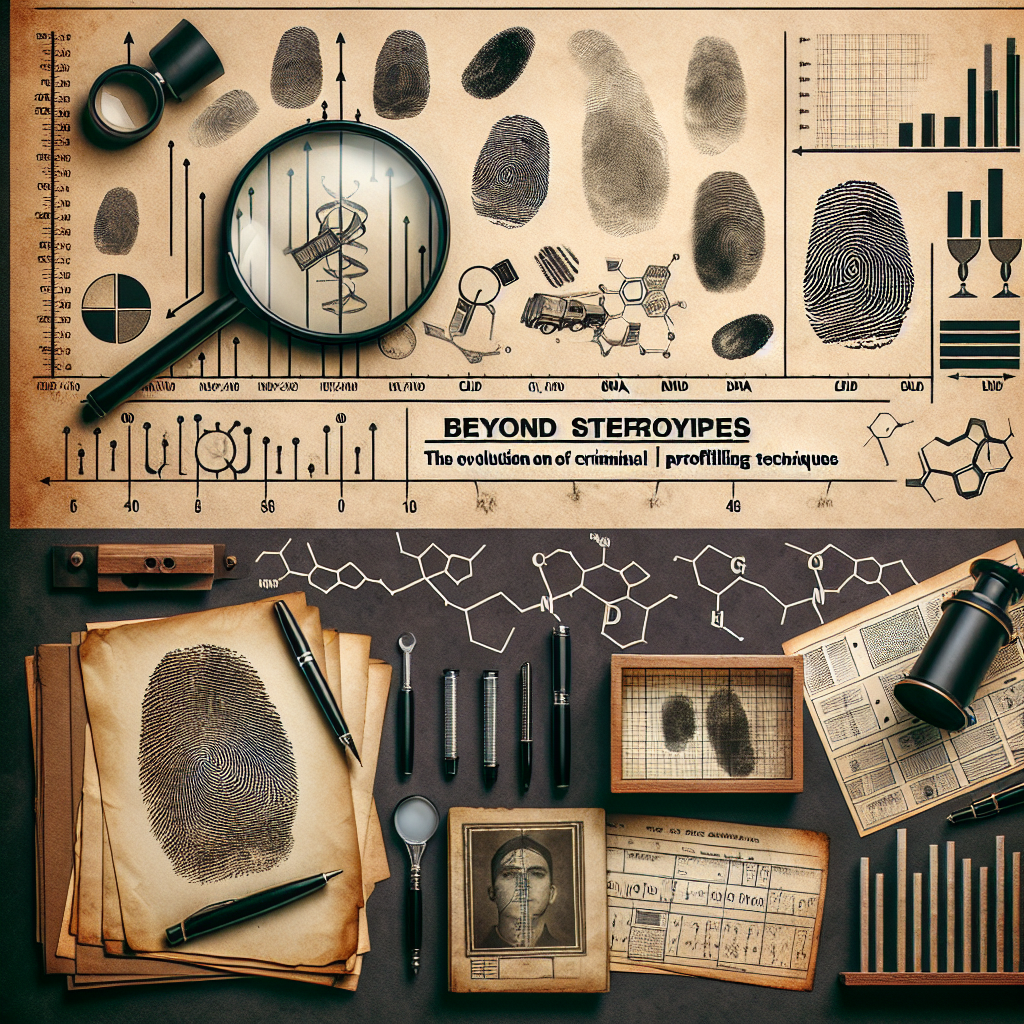
Introduction
In the realm of criminal justice, the art and science of criminal profiling have undergone a remarkable metamorphosis. From early misconceptions to sophisticated methodologies, the journey of profiling can be both intriguing and complex. The phrase "Beyond Stereotypes: The Evolution of Criminal Profiling Techniques" aptly captures this evolution, inviting us to explore how profiling has transcended simplistic assumptions to become an essential tool in solving crimes. In a world where every criminal act is intertwined with psychological undercurrents and socio-economic factors, a nuanced understanding of criminal behavior is more vital than ever.
As we delve into this captivating subject, we will examine the history, methodologies, and case studies that illustrate how modern profiling is reshaping investigative approaches. Through this exploration, readers will gain unique insights that challenge preconceived notions and foster a deeper appreciation for the dynamic landscape of criminal profiling.
The Historical Context of Criminal Profiling
Early Beginnings
The origins of criminal profiling can be traced back to the late 19th and early 20th centuries. Early attempts at understanding criminal behavior were rudimentary, often relying on stereotypes based on social class, race, and gender. Figures like Cesare Lombroso, who theorized that criminals were "born" with certain physical traits, shaped early profiling techniques, resulting in significant ethical concerns and misguided assumptions.
The Rise of Psychological Profiling
The landscape of criminal profiling began to evolve dramatically in the 1970s with the integration of psychology into investigative techniques. The establishment of the FBI’s Behavioral Science Unit marked a pivotal moment. This unit focused on understanding the psychological motivations behind criminal actions rather than merely attributing them to stereotypes.
Case Study: The Atlanta Child Murders
One example that showcases the shift from stereotypical thinking to a more psychological approach is the Atlanta Child Murders. Investigators initially struggled with a lack of leads and community distrust. However, through psychological profiling, they were able to identify patterns in victims and potential suspects, ultimately leading to the arrest of Wayne Williams. This case illuminated the power of context over stereotype, enabling the FBI to track the killer through behavioral analysis rather than through preconceived notions about who a killer might be.
Modern Techniques of Criminal Profiling
The Advent of Criminal Profiling Models
As the study of criminal behavior advanced, various models emerged to categorize and better understand offenders. The FBI’s Organisational and Disorganised Model classifies offenders based on their planning and execution stages.
Table 1: Organised vs. Disorganised Offenders
| Trait | Organised Offender | Disorganised Offender |
|---|---|---|
| Plan of Action | Highly planned | Impulsive |
| Victim Choice | Selective (often known to the offender) | Random or opportunistic |
| Crime Scene | Neat and structured | Chaotic and unorganized |
| Social Skills | Good interpersonal skills | Poor interpersonal skills |
Behavioral Analysis in the Digital Age
The evolution of technology has revolutionized criminal profiling techniques. Now, with vast data sets and analytic software, investigators can analyze patterns and trends in ways never before possible.
Case Study: Cyber Crimes
Take, for instance, cybercrimes, where traditional profiling methods proved futile. With the digital footprint criminals leave behind, analysts can utilize algorithms and machine learning to identify potential offenders by their online behavior. The FBI’s use of technology in tracking cybercriminals demonstrates the significant shift Beyond Stereotypes: The Evolution of Criminal Profiling Techniques into data-driven profiling approaches that rely on behavior rather than outdated stereotypes.
The Ethical Implications of Profiling
The Risks of Misprofiling
Despite advancements, profiling isn’t without its challenges. The reliance on stereotypes can lead to misprofiling, which has severe real-world implications. Skewed interpretations may lead to wrongful accusations and systemic discrimination.
Cultural Sensitivity in Profiling
The growing focus on more comprehensive and culturally sensitive profiling methods cannot be overstated. A more nuanced understanding of cultural practices and social dynamics is crucial in crafting effective profiling techniques that hone in on behavior without defaulting to stereotypes.
Case Studies and Real-World Applications of Profiling
The Green River Killer
Another case that reflects the journey Beyond Stereotypes: The Evolution of Criminal Profiling Techniques is the investigation of Gary Ridgway, also known as the Green River Killer. Early investigations were hampered by a lack of understanding of the dynamics involved in the crime. However, dedicated profiling efforts eventually led to his capture, as investigators began looking beyond surface-level assumptions to understand the emotional complexities involved.
The Unabomber: Ted Kaczynski
In the case of Ted Kaczynski, investigators relied heavily on profiling to identify behavioral patterns that led to his eventual capture. The Unabomber’s manifesto provided invaluable insights into his psyche, and contrasting his background with traditional stereotypes enabled investigators to finally pinpoint him as a suspect. This case underscores the importance of considering psychological and social factors over simplistic categorizations.
Table 2: Profiling Applications in High-Profile Cases
| Case Name | Profile Variables Used | Outcome |
|---|---|---|
| Atlanta Child Murders | Victimology & Patterns | Arrest of Wayne Williams |
| Green River Killer | Behavioral Analysis | Gary Ridgway’s conviction |
| Unabomber | Psychographic Profiling | Identification of Ted Kaczynski |
The Future of Criminal Profiling
Innovations and Technologies
As we venture further into the 21st century, the integration of artificial intelligence, deep learning, and advanced analytics promises to revolutionize profiling techniques. These technologies can sift through extensive datasets, unearthing connections between seemingly unrelated incidents and suspects.
The Importance of Continuous Education
A critical aspect of progression in criminal profiling is ongoing education. Investigators must remain updated on psychological theories, ethical considerations, and emerging technologies to avoid returning to outdated stereotypes.
Conclusion
As we conclude this exploration of "Beyond Stereotypes: The Evolution of Criminal Profiling Techniques," it is clear that while the foundations of profiling were built on a variety of misconceptions, today’s approaches are increasingly nuanced and sophisticated. The blending of psychology, technology, and ethical considerations enriches the field, allowing law enforcement to solve crimes more effectively.
Ultimately, the pathway ahead calls for a commitment to continuous learning and adaptation. By moving beyond stereotypes, we not only enhance the efficacy of criminal profiling but also foster a more just and equitable society.
FAQs
1. What is criminal profiling, and how does it work?
Criminal profiling involves analyzing behavioral patterns and psychological motivations to identify the characteristics of an offender. It combines forensic science, psychology, and investigative techniques to narrow down suspect lists.
2. How has technology impacted criminal profiling?
Technology has enabled law enforcement to analyze vast amounts of data quickly. Through machine learning and AI, analysts can identify patterns in criminal behavior that were previously undetectable.
3. What ethical concerns surround criminal profiling?
Profiling can lead to stereotyping, racial profiling, and wrongful accusations. Ethical concerns highlight the importance of using nuanced and sensitive approaches that ensure justice and minimize bias.
4. Can criminal profiling help in cases of cybercrime?
Yes, criminal profiling is increasingly utilized in cybercrime investigations, allowing investigators to analyze online behaviors and patterns to identify suspects effectively.
5. How can I learn more about criminal profiling?
Resources such as academic journals, documentaries, and books by established criminologists provide a wealth of knowledge on both historical and contemporary profiling techniques.
In summary, "Beyond Stereotypes: The Evolution of Criminal Profiling Techniques" is not just a phrase; it represents a fundamental shift in understanding human behavior in relation to crime, demanding respectful engagement and careful innovative change moving forward.

















